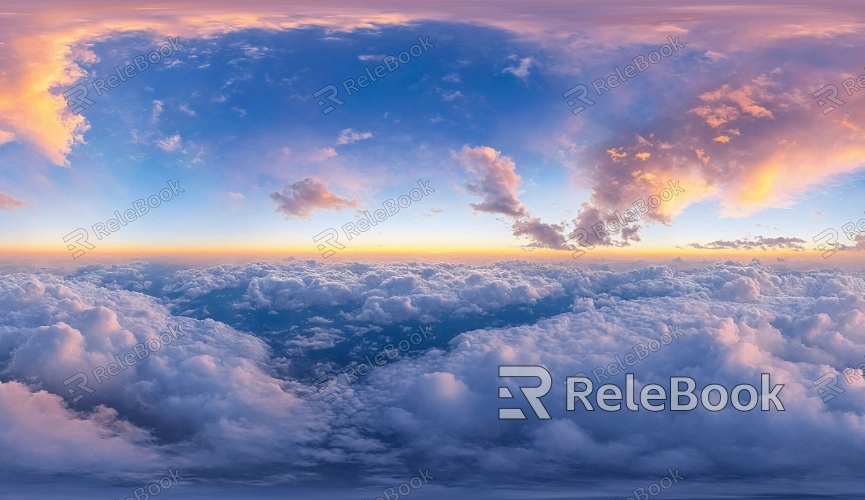How to Optimize HDR Skybox Textures for Real-Time Rendering
Whether in game design, architectural visualization, or virtual reality projects, HDR skybox textures add depth to lighting and realistic environmental reflections. However, since HDR textures contain rich lighting information, using unoptimized HDR skyboxes in real-time rendering can burden performance. To maintain image quality while meeting rendering performance demands, designers need to take specific optimization steps. This article explores effective ways to optimize HDR skybox textures for real-time rendering projects and how to apply these techniques in commonly used software like Blender, 3ds Max, and Unreal Engine.

1. Adjust Resolution and Detail Levels
HDR skybox textures often contain an abundance of detail, so adjusting their resolution is an essential step in optimization.
Balancing Resolution and Performance: While high-resolution HDR textures offer better lighting effects, excessive resolution in real-time rendering projects can reduce frame rates. Designers should select an appropriate resolution based on the scene's needs. Typically, a texture resolution of 2048x2048 pixels suffices for most scenarios. Extremely high resolutions should be used sparingly, especially in large-scale scenes.
Dynamic Detail Adjustment: Reducing detail in less critical areas can help save memory. For example, distant or non-essential visual elements can have simplified textures, easing the strain on rendering performance.
2. Compress HDR Texture Files
Using compression techniques without significantly affecting visual quality is a key strategy to reduce HDR texture file size.
Specialized Texture Formats: Formats like ASTC and BC6H are designed to handle high dynamic range textures. These formats significantly reduce file size while preserving lighting details. By employing such formats, designers can enhance load times and reduce memory usage in real-time rendering environments.
Reducing Color Bit Depth: In cases where smooth color transitions and lighting changes aren't critical, reducing the HDR texture’s bit depth is another option. For instance, dropping from 32-bit floating-point color depth to 16-bit may not cause noticeable quality loss but can dramatically reduce file size.
3. Optimize the UV Layout of Textures
The UV mapping of HDR skybox textures plays a significant role in rendering efficiency.
Minimizing Redundant Areas: When creating a skybox, avoid wasting space in the UV map, particularly in parts of the texture that represent less visible or irrelevant areas. A compact, efficient UV layout reduces the number of unused pixels the renderer must process.
Allocating UV Space Effectively: In real-time rendering, visually critical areas should take up more UV space, while less important areas can be allocated less space. This improves texture resource utilization and decreases the load on the GPU.

4. Simplify Lighting Data
Although HDR textures carry intricate lighting information, simplifying some of this data can improve performance.
Pre-Calculated Lighting: Game engines and rendering software often offer the ability to pre-calculate lighting and bake it into textures. This method retains high-quality lighting effects while reducing the amount of real-time computation required during rendering.
Trimming Extremes in Brightness: Some very bright or dark areas in an HDR texture may have little impact on the final output. By reducing lighting data in these areas, performance can be optimized without a noticeable loss in quality.
5. Utilize Real-Time Rendering Engine Optimization Features
Many modern rendering engines, like Unreal Engine and Unity, offer built-in optimization features for real-time rendering.
Level of Detail (LOD) System: By setting different resolutions for HDR textures, the LOD system can dynamically load textures of varying precision based on the camera’s distance. This way, distant HDR skyboxes use lower-resolution versions, while close-up views retain high-resolution textures, significantly improving performance.
Enabling Motion Blur or Anti-Aliasing: Some rendering engines provide motion blur and anti-aliasing techniques to maintain a smooth and clear image while optimizing frame rates. These techniques can effectively reduce the demand on HDR textures without noticeably affecting the visual output.
6. Control HDR Exposure and Brightness
HDR skybox exposure and brightness parameters directly influence both rendering performance and visual results.
Lowering HDR Exposure: In some cases, HDR skyboxes may have excessively high exposure, which can cause overwhelming lighting effects and decrease rendering efficiency. By lowering the exposure, designers can reduce the load on the GPU while retaining natural lighting transitions.
Balancing Brightness with Reflections: Adjust the brightness of the HDR skybox based on the scene's requirements to achieve the best balance between reflection and lighting effects. This ensures that enough detail is preserved without creating overly bright or dark visuals that could affect the final image.
7. Reduce the Number of Real-Time Light Sources
In scenes that use HDR skyboxes, additional real-time light sources can increase rendering load.
Leveraging HDR’s Built-In Lighting: Since HDR skyboxes contain rich lighting information, the need for additional light sources is often reduced. By effectively using the lighting data within the HDR texture, designers can minimize the reliance on real-time light sources and improve rendering performance.
Simplifying Real-Time Lighting Settings: For scenes that require additional lighting, reducing the number and complexity of real-time light sources can effectively boost frame rates without significantly affecting the overall visual quality.
By applying these optimization strategies, designers can improve the performance of HDR skybox textures in real-time rendering projects without significantly compromising visual quality. Whether in game development, architectural visualization, or virtual reality projects, optimizing HDR textures can not only enhance performance but also ensure that the final result maintains a realistic and immersive visual experience.
If you're looking for high-quality HDR textures, 3D models, or design assets, Relebook offers a wide selection to help you achieve exceptional rendering results across various projects.

